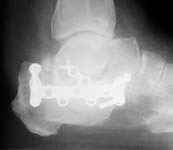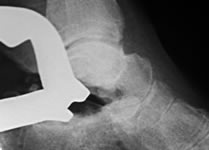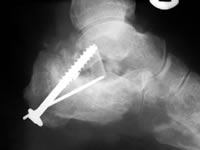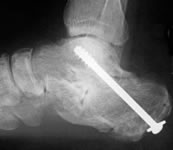Primary subtalar fusion
Gallie (1943) suggested that the subtalar joint could not be reconstructed accurately enough to prevent arthritis developing and proposed primary posterior subtalar arthrodesis. Early series produced contradictory results. Sanders (1993) considers that severely comminuted fractures are probably best treated by primary arthrodesis after restoration of calcaneal height.
Schepers (2012) carried out a sytematic review of seven series of primary fusion, including 120 patients. Methodology in most series was modest. Union rates varied from 90-100% with a mean of 97%. Mean AOFAS score across all patients was 77.4/94 (because of the enforced loss of subtalar movement). In four studies which reported return to work, this occurred in 75-100% of patients. 19.4% had wound healing complications including local infections; there were seven cases of osteomyelitis and three amputations. The overall results are no worse than those of ORIF or non-surgical treatment although the complication rates are higher. Gurkan (2011) reported similar AOFAS scores (mean 72) in 84 patients with Sanders 4 fractures treated non-surgically. This seems another area where a trial is required.
Reconstructive fusion techniques
A proportion of patients will develop disabling subtalar OA whatever their primary management. Buckley et al found this was five times more likely in those initially treated non-operatively. There are three main techniques available:
- fusion in situ, accepting some loss of heel height
- distraction fusion, using tricortical iliac crest graft to elevate the talus and restore heel height
- taking down the original fracture line, reconstructing calcaneal anatomy and fusing as close as possible to the original height
There are no RCTs comparing any of these methods, and given the rarity of this clinical condition there are unlikely to be such trials.
Amendola (1996) reported resolution of anterior impingement pain in 8/9 patients after distraction fusion. However, Flemister (2000) found similar results in patients treated with in-situ fusion and distraction fusion, but with more non-unions and mal-unions in the distraction fusion group. Savva and Saxby (2007) reported results of in-situ fusion comparable to distraction fusion, with only one patient complaining of anterior ankle pain (although they do not record how many patients had anterior pain before fusion). We therefore prefer to fuse in situ, unless there is anterior ankle impingement because of talar dorsiflexion, when distraction will correct talar alignment, provided the additional complexity and risk seems reasonable for the individual patient.
There is no evidence that primary subtalar fusion is better than initial non-surgical management followed by late fusion in the patients who have disabling pain from the subtalar joint.
It is sometimes argued that initial ORIF will provide a better position than non-surgical treatement for subsequent subtalar fusion if required. Thermann et al (1999) found little difference between the results of fusion after ORIF or non-surgical treatment in a retrospective study, although the ORIF group had worse fractures initially. However, Radnay et al (2009 - Sanders' group) compared a group of patients who had in-situ fusions after primary ORIF with a group who had distraction fusions after conservative treatment. The first group had significantly better AOFAS (87/94 compared with 74) and Maryland (91/99 compared with 79) foot scores. There were more soft-tissue complications in the group who had been treated non-surgically; Radnay attributed this to the effect of distraction. In a somewhat tendentious discussion, the authors considered this evidence to support the initial surgical treatment of calcaneal fractures. However, as the patients were apparently allocated to treatment plans by surgeon choice and had different savage procedures despite the lack of evidence that distraction is necessary, it is difficult to draw such firm conclusions from this series. Combining Thermann and Radnay's results, however, leaves a possibility that late reconstruction may be easier after ORIF. Unfortunately Buckley's (2002 and subsequently) large RCT reported this only in a subsidiary paper (Csizy 2003) which used a different outcome measure to the main paper but implies the results of fused patients were similar to those of patients in the trial generally.

Collapse of the talus into the calcaneum after fixation of a highly comminuted calcaneal fracture. The patient had significant anterior ankle impingement

Intra-operative image. The subtalar joint remnant is taken down and the talus elevated with a laminar spreader or femoral distractor

Tricortical and cancellousgraft are used to maintain the correction. There has been about 10deg loss of correction at union but arthritic pain and impingment are minimal

Fusion in situ after calcaneal fracture. Although there is loss of height, the patient was satisfied to be rid of his arthritic pain and returned to work
